INTRODUCTION
Shallow lakes are an essential component of the Argentine Pampean wetlands, one of the most extensive wetland areas in South America. Lakes on the plain are shallow with brief periods of thermal stratifica tion (Quirós, 2005). Shallow lakes often alternate between two states: a turbid one, in which phytoplankton dominates productivity; and a re latively clearer vegetated state, in which rooted vegetation dominates productivity (Scheffer et al., 1993; Scheffer et al., 2003). There is a third state of shallow lakes found in the Argentine Pampean wetlands, which also corresponds to turbid lakes, in which turbidity is mostly due to suspended inorganic material (Torremorell et al., 2007). Bilotta & Bra zier (2008) defined turbidity as a measure of the light scattering pro perties of water, and their readings were influenced by the particle size and shape of suspended solids, the presence of phytoplankton, and the presence of dissolved matter and mineral substances. These systems normally show a high sequential phytoplankton population variability with frequent changes in the composition and relative abundance of species as a result of the interactions between the physical, chemical, and biological variables (Calijuri et al., 2002) that have a notable in fluence on the structure of the phytoplankton community (Rojo et al., 2000; Phlips et al., 2002). The Sauce Grande shallow lake is a typical shallow Pampean lake (Ringuelet, 1972), given its shallow nature and the homogeneity of its physicochemical and biological parameters. This homogeneity is frequently affected by both extreme drought and in tense rainfall, which produce drastic changes within its structure and performance (Quirós et al., 2002a, b). Shallow lakes, which are globally the most common and widespread inland water bodies (Downing et al., 2006), are particularly vulnerable to drought and unbalanced ratios between evaporation and precipitation (Jeppesen et al., 2009; Moss et al., 2011) due to their large surface:volume ratio (Coops et al., 2003). In this sense, Izaguirre et al. (2015) demonstrated the vulnerability of most Pampean shallow lakes to water level fluctuations. Moreover, the struc ture and dynamics of the phytoplankton community may be susceptible to climatic changes that alter the level of the lake water through eva poration and changes in the flow of the stream network in the water supply basin (Coops et al., 2003).
The Sauce Grande shallow lake was recently characterized as a murky water body dominated by phytoplankton (Ferrer et al., 2012). In the fall of 2010 it was found to be in a eutrophic condition based on measurements of chlorophyll a and water transparency (Ferrer et al., 2012) and even hypertrophy was recorded during 2012-2013 (Cony et al., 2014).
Although there are studies of the lake’s phytoplankton (Ferrer et al., 2012; Cony et al., 2014), none of them has dealt with the relationships between biotic and abiotic variables. The aim of this investigation was to analyze the temporal and spatial distribution of abundance in the phyto plankton community of the Sauce Grande shallow lake relating these factors to the physicochemical variables of the water body. The study was carried out under the premise that phytoplankton populations are sensitive to internal physicochemical fluctuations of the water body and to prevailing environmental conditions that affect their abundance and distribution. We suggest that a better comprehension of phytoplankton dynamics in this shallow lake will be achieved by the correlation with physicochemical variables. In this paper, we intend to identify the va riables that are most influential on the phytoplankton community, in particular temperature, turbidity, pH, electric conductivity, and salinity. Knowledge of the Sauce Grande shallow lake phytoplankton dynamics will be an important tool for a better understanding of shallow water systems in the Pampean wetlands.
MATERIALS AND METHODS
The Sauce Grande shallow lake is located in southwestern Buenos Aires Province, Argentina (38º 57 ‘S-61º24’ W). This system has an area of 21.55 km2 and depths ranging between 0.60 m and 1.80 m, with a historical average depth of 1.40 m (Fornerón et al., 2010a). The Sauce Grande River feeds the shallow lake from the west and drains it to the east before flowing into the sea (Fig. 1). The region is temperate and hu mid with mean annual temperatures between 14 ºC and 20 ºC (Ferrer et al., 2012). Rainfall is irregular, ranging between 600-700 mm annually. The Sauce Grande shallow lake has an interesting regional importance because of the numerous recreational activities that take place there throughout the year.
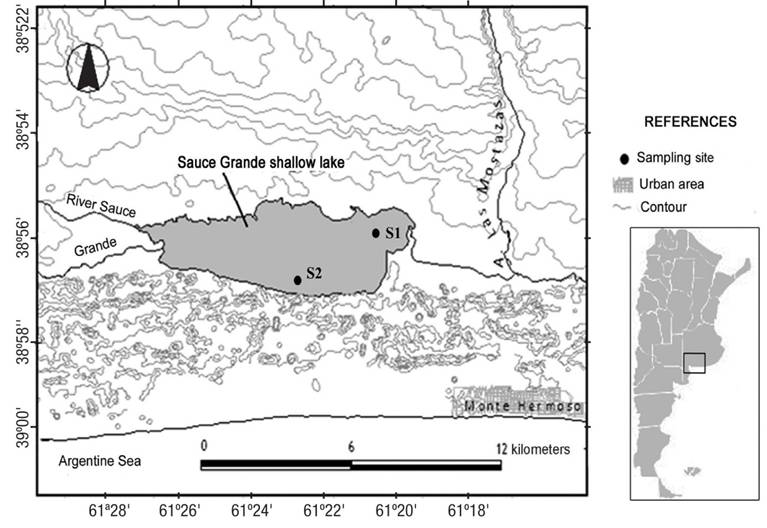
Figure 1 Location of the Sauce Grande shallow lake (Argentine Pampean wetland) and sampling sites (S1 and S2).
Monthly samples were collected from April to September 2012 at two easily-accessible sites: S1, representative of the littoral sector of the lagoon near the exit of the Sauce Grande River, and S2, in the re creational sector (Fig. 1). The water body was extremely shallow during the study period, preventing access by any type of boat. Water envi ronmental variables were recorded in situ: temperature (°C), turbidity (NTU), pH, electric conductivity (EC, mS.cm-1), and salinity (PSU), with a Horiba U-10 multisensor. In addition, transparency was estimated using a Secchi disk.
Qualitative samples, subsurface mode, were taken with a plankton net of 30 µm mesh aperture, one from each sampling site, and were fixed, in situ, with 4% formaldehyde. Observations were made with two microscopes, a Leitz SM Lux and a Zeiss Axiolab. We identified the sam ples with specialized literature for the dominant algal groups (Bourrely, 1966; Hindák, 1977, 1984, 1988, 1990; Komárek & Anagnostidis, 1999, 2005; Komárek & Fott, 1983) and with similar studies conducted in the Pampean wetlands (Guarrera et al., 1968, 1972).
Quantitative analyses were performed on samples taken sub-su perficially with plastic bottles and fixed in situ with Lugol’s solution. Counts were made under a Nikon Eclipse TE 300 inverted microscope with Nikon Digital Sight DS-U2 incorporated, with a Sedgwick-Rafter camera, according to the method of McAlice (1971). Abundance was expressed as the number of individuals per milliliter (ind.ml-1).
In order to analyze the similarity between sampled sites and mon ths, a cluster analysis was performed based on a complete linkage of the physicochemical and environmental variables (conductivity, depth, pH, temperature, salinity, and turbidity.) In addition, a Spearman corre lation was performed between these physicochemical variables and the abundance of the represented taxonomic groups.
Moreover, two principal component analyses (PCA-1 and PCA-2) were performed, to locate and relate the biological and physicochemi cal variables in space. PCA-1 was based on the abundance of repre sented taxonomic groups together with physicochemical variables for each site, whereas in PCA-2 the phytoplankton specific abundances were related to the occurrence frequencies (FO) ≥70%. In all cases, logarithmic transformed data were used. The “Infostat Student Version” software was used for the analyses.
RESULTS
Physicochemical factors.Table 1 shows the values of the environ mental variables recorded at the sampling sites. Mean pH values were 10.1 and 10.4 at sites 1 and 2 respectively, conductivity rose from 6.3 to 10.1 mS.cm-1, and the minimum was recorded at site 2 and the maximum at site 1 (Fig. 2). Salinity averaged 0.5 PSU at both sites. Turbidity was high throughout the entire study period, with saturation values of 999 NTU at both sites.
Table 1 Minimum, maximum, average (), and standard deviation (SD) of the physicochemical variables recorded during April-September 2012 in an Argentine Pampean wetland. Values: NTU: Natural Turbidity Units; PSU: Practical Salinity Units.

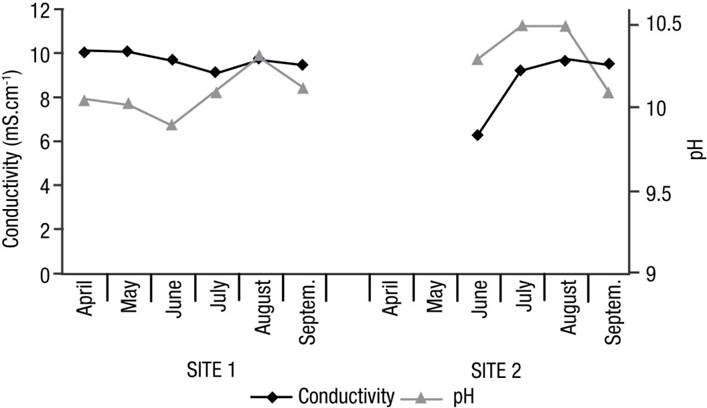
Figure 2 Changes in the conductivity and pH over the study period (2012) at sites 1 and 2 at the Sauce Grande site (Argentine Pampean wetland).
Depths recorded in August 2012 were very low at both sites, the mini mum being 0.10 m for site 2 and the maximum 0.5 m for site 1.
Phytoplankton qualitative analysis. The phytoplankton composition was similar for both groups and species at both sampling sites. Of 54 taxa identified, 30 were Chlorophyta (55.5 %), 14 belonged to Cyano bacteria (26 %), and 10 to Bacillariophyta (18.5 %). From the latter, seven (70 %) were pennate and three (30 %) centric (Fig. 3). Table 2 shows the species identified at both sites: Dictyosphaerium ehrem bergianum Näegeli and Oocystella borgei (J.Snow) Hindák were only found in August 2012 at site 2; Oocystis eremosphaeria G.M. Smith appeared in May, July, and August only at site 2; Pediastrum borya num (Turp.) Meneghini in August at site 2 and Planctonema lauterbor nii Schmidle were only found in May 2012 at both sites; Staurastrum planctonicum (Teiling), Tetraedron caudatum (Corda) Hansgirg, and T. minimun (A. Braun) Hansgirg were only identified at site 1. Meanwhile, the Cyanobacteria Aphanotece clathrata (West et G.S.West) was found in September 2012, only at site 1. Among diatoms, Chaetoceros mue lleri Lemmermann only appeared in April 2012 at site 2, Navicula aff. gregaria Donkin was found at site 1 in April, August, and September; Pseudostaurosira brevistriata var. inflata (Pantocsek) Hartley only in July and September, and Surirella striatula Turpin in August 2012, at both sites 1 and 2.

Figure 3 Number of phytoplankton taxa of the three principal groups found during the study period at the Sauce Grande site (Argentine Pampean wetland).
Table 2 List of the phytoplankton taxa recorded in the Sauce Grande shallow lake, in an Argentine Pampean wetland, during April-September 2012 for site 1 and site 2. Differential species at each site are highlighted in gray. Only the keys of the taxa with ≥70% frequency of occurrence are presented, as selected for the PCA-2.

Phytoplankton quantitative analysis. The ANOVA performed on phytoplankton abundance did not detect differences between sampled sites (F = 0.005, p >0.05). However, significant differences between months (F = 6.36, p <0.05) were found. A cluster analysis to group months regarding abundance (Fig. 4) was also performed. April and September, July and May, and June and August were grouped for this analysis.
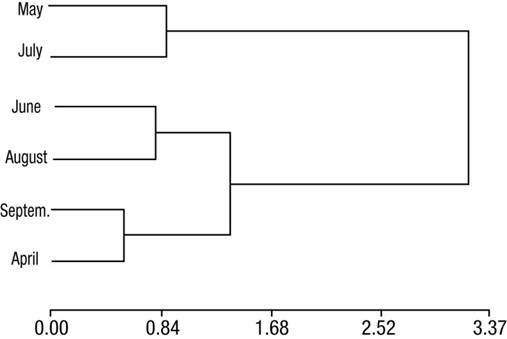
Figure 4 Cluster grouping of monthly samples according to phytoplankton abun dance. Complete linkage. Distance: Euclidea.
At site 1, total abundance showed values of 3.6x106 ind.ml-1 in September and 5.4x106 ind.ml-1 in July 2012 (Fig. 5). At site 2, abun dance ranged from 4.0x106 to 5.1x106 ind.ml-1 in April and May 2012, respectively. The total average phytoplankton abundance was 4.4x106 ind.ml-1 at both sites, and Cyanobacteria were the most abundant group, followed by Chlorophyta and Bacillariophyta (Fig. 5). Synecho cystis salina Wislouch was the dominant species throughout the entire period, reaching a relative representation of 47% of the total abundan ce in September at site 1 and 45% in August at site 2. Chroococcus minimus (Keissler) Lemmermann, Aphanocapsa elachista W. West et G.S. West and A. nubilum Komárek et Kling were the species with the second highest abundance at both sites.
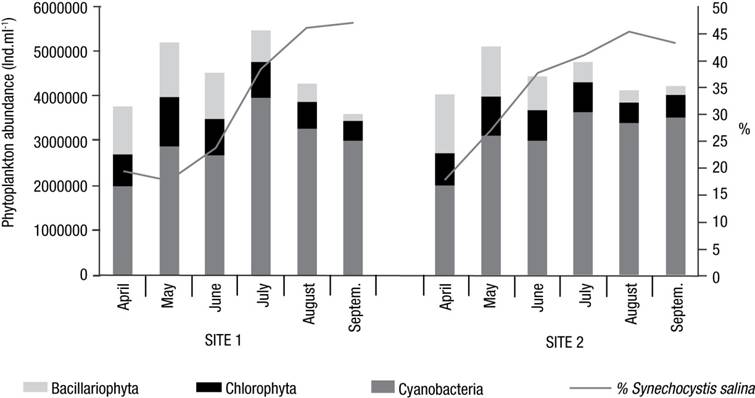
Figure 5 Monthly variation of the abundance of the phytoplankton taxonomic groups and the percentage of the dominant species (Synechocystis salina) during the study period at both Sauce Grande study sites (Argentine Pampean wetland).
Cluster Analysis The cluster analysis performed on the physicochemi cal variables (conductivity, temperature, depth, pH, salinity, and turbidi ty) appears in the figure 6. Three groups were established: 1) a “cold” group (S1 May, June, and July), in which the temperature did not exceed 8° C and the conductivity and depth averaged 9.5 mS.cm-1 and 0.27 m, respectively; 2) a “warm” group (S1 April, S1 August, and S1 and S2 September), with the temperature above 12 ºC and conductivity greater than 9.5 mS.cm-1, and 3) a “alkaline” group (S2 July and August) with high pH records (10.5). The lowest conductivity value of 6.27 mS.cm-1 caused the sample S2 June to be separated from the other groups.
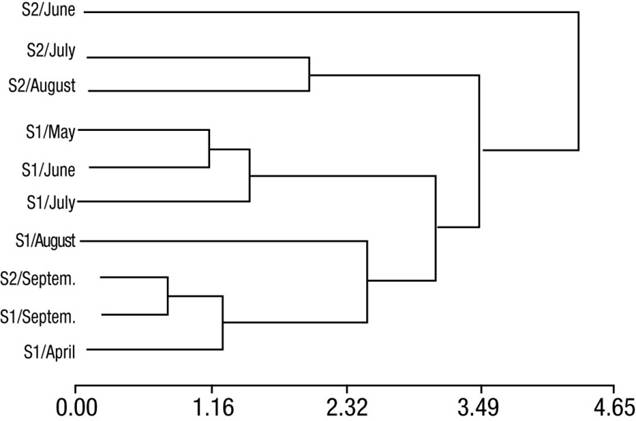
Figure 6 Cluster grouping of sampling stations according to the physicochemical variables. Complete linkage. Distance: Euclidea.
Principal Component Analyses (PCA). The PCA-1 included the abun dance of the represented taxonomic groups (Cyanobacteria, Chlorophyta, and Bacillariophyta) during the entire study period in conjunction with the physicochemical variables for each sampling site shown in Figure 7. The turbidity was included in the analysis, but did not show correlation with any axis, so the variable was removed from the graphic result. For S1, the first two ordination axes explain 85.5% of the total variance (Fig. 7A), the positive portion of the first axis represents the conductivity, salinity, and abundance of Bacillariophyta, and the negative portion relates to the pH and the abundance of Cyanobacteria. The second axis is related to the temperature, the depth (positive portion), and the abundance of Chloro phyta (negative portion). April was characterized by the highest salinity and conductivity and less phytoplankton abundance, especially of Cya nobacteria, whereas samples from May and June showed a high density of Chlorophyta and Bacillariophyta individuals, as well as lower pH and depth records. July had the highest phytoplankton abundance, in particu lar Cyanobacteria, and the lowest temperature and depth records. During August and September the highest pH and depth records and the lowest phytoplankton abundance of Chlorophyta and diatom representatives oc curred (Fig. 7A). For site 2 (Fig. 7B), the first two ordination axes explained 82.9%, the positive portion of the first axis represents the abundance of Bacillariophyta and Chlorophyta, and the negative portion relates to the abundance of Cyanobacteria, temperature, conductivity, and salinity. The second axis is related to the pH (positive portion) and depth (negative portion). June showed the highest abundance of Chlorophyta and Baci llariophyta. July and August showed high pH, salinity, conductivity, and a significant abundance of Cyanobacteria. September had high temperatu re and depth records and lower abundances of green algae and diatoms (Fig. 7B).

Figures 7a-b PCA-1. Biplot of samples and abundance of taxonomic groups, in the plane of the first two principal components, for Site 1 (a) and Site 2 (b) at Sauce Grande (Argentine Pampean wetland).
The PCA-2 was based on the specific abundance of selected spe cies with the FO≥70% parameter that explained 71.2% of the total variance (Fig. 8). This analysis allowed us to establish a monthly or dination of samples without finding any differences between sampling sites. In this regard, April samples were related to a high abundance of Scenedesmus nanus Chodat; May and June showed high abundance of Juranyiella javorkae (Hortobágyi) Hortobágyi and Tetraedron muti cum (A. Braun) Hansgirg (Chlorophyta), Aulacoseira granulata (Ehren berg) Simonsen, and Hyppodonta sp. (Bacillariophyta). July showed the highest abundance of Monoraphidium contortum (Thuret) Komárková-Legnerová, Tetrastrum staurogenieforme (Schröder) Lemmermann (Chlorophyta), and A. elachista (Cyanobacteria). The samples of August and September were characterized by a low abundance of selected species and a high abundance of the dominant species S. salina and Aphanocapsa holsatica (Lemmermann) Cronberg et Komárek.
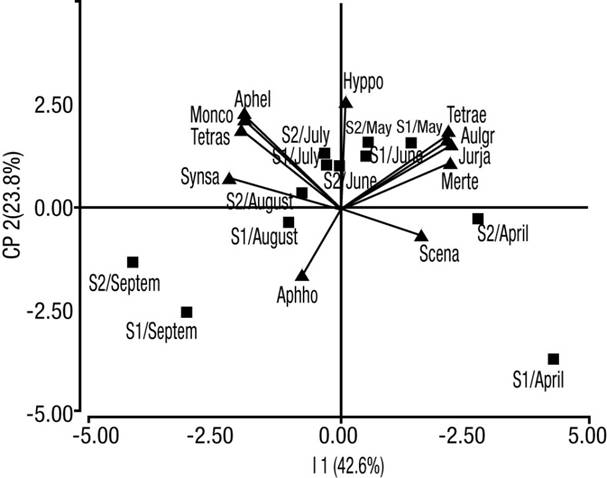
Figure 8 PCA-2. Biplot of samples and species selected in the plane of the first two principal components, depending on specific species abundance. For the species key, see Table 2.
Spearman Correlations. The different taxonomic groups showed significant correlations (p <0.05) with the different water physicoche mical and environmental variables recorded (Table 3). The exception was turbidity, which showed no correlation with any taxonomic group. Cyanobacteria exhibited a positive correlation with conductivity at site 1 (R-Spearman = 0.77), whereas Chlorophyta and Bacillariophyta were negatively correlated with conductivity (R-Spearman = -0.80 for both), temperature (R-Spearman = -0.80 for both), and salinity (R-Spearman = -0.74 and -0.95, respectively). Diatoms showed a positive correlation with conductivity and a negative correlation with pH (R-Spearman = 0.83 and -0.77 respectively) at site 1.
DISCUSSION
The water level of the Sauce Grande shallow lake during our study pe riod was significantly lower than the decrease that occurred during fall 2010 (Ferrer et al., 2012). It is known that this water body is highly dependent on in situ rainfall (Fornerón et al., 2010b) and the severe drought recorded in the area may be related to the ongoing global war ming tendency (see Resolution331/2010 of the Agriculture, Livestock, and Fisheries Ministry of Buenos Aires Province, http://www.minagri.gob.ar). Moreover, the man-made water deviation from the tributary river to adjacent fields worsened the situation (see data provided by the Water Authority, Infrastructure Ministry, Buenos Aires Province, http://www.ada.gba.gov.ar).
The decrease in the water level was accompanied by an increase in turbidity, with saturation values throughout the study period. According to Cony et al. (2014) who studied the nature of the suspended organic matter in the lake, the phytoplankton community was mainly respon sible for the turbidity, although no clear correlation between phyto plankton abundance and turbidity was found. The increase in turbidity was also derived from the concurrent effect of sediment removal by wind and the shallow depth, also mentioned by other authors for these environments (James et al., 2004; Quirós et al., 2005, Lagomarsino et al., 2015). Our results made it clear that there was no evident action by any of the other physicochemical variables studied.
Nevertheless, the total phytoplankton density values recorded of 106 ind.ml-1 during the study period, exceeded the values by an order of 103 ind.ml-1 with respect to those recorded in autumn 2010 (Fe rrer et al., 2012). In particular, Cyanobacteria densities exceeded the 1x104 cells.ml-1, densities that, according to Pizzolon (1996), can be considered a cyanobacterial bloom. In particular, O’Farrell et al. (2015) highlight the role of changes in water level in the Pampean wetlands in altering phytoplankton abundance and especially in establishing cyanobacterial blooms. Moreover, these authors also mention that the sequence of nutrient mobilization from land to the receiving waters after intense rainfall and flushing subsidence followed by protracted periods of drought could explain the massive cyanobacterial blooms in estuaries, reservoirs, and lakes (O´Farrell et al., 2015). Previous research has shown that the underwater light climate could strongly affect the phytoplankton structure and primary production in the lakes of this region (Allende et al., 2009). Light-limiting conditions prevail in the turbid Pampean lakes (Llames et al., 2009), and it is known that light availability affects algal competition (Reynolds, 2006) and phytoplankton diversity (Reynolds, 1998; Stomp et al., 2004). Rey nolds (1994) noted that large amounts of suspended material have a profound effect on the attenuation of underwater light, with subse quent selection of ‘’light antenna,’’ which favors species that have a large surface/volume ratio (SA/V). Small chroococcalean Cyanobacte ria species are clearly well adapted to these conditions due to their high SA/V (Izaguirre et al., 2015). In this study, the dominant species was precisely Synechocystis salina and the subdominant ones were Chroococcus minimus, Aphanocapsa elachista, and A. nubilum.
Cony et al. (2014) recently described the Sauce Grande shallow lake as hypereutrophic due to the high levels of chlorophyll, the high pH records, and the stability in the water column. In addition, the sa linity recorded was higher in 2012 than in 2010 (Ferrer et al., 2012), as a result of the prolonged hydraulic residence times caused by the drought (see Beklioglu et al., 2007 and Beklioglu et al., 2011), a si tuation that also favors incipient cyanobacterial blooms (see Sellner et al., 1988).
All these factors could explain the abundance of cyanobacteria in general and the dominant species in particular. Several authors (Havens et al., 1998; Huisman & Hulot 2005; Havens, 2008) have mentioned that (1) high concentrations of nutrients, (2) high water temperature, (3) high pH values, (4) low N:P, and (5) stability of the water column are causati ve factors involved in the development of cyanobacterial blooms.
Qualitatively, the phytoplankton community was not very different from that of autumn 2010, when Chlorophyta also had the highest num ber of recorded taxa, followed by Cyanobacteria and Bacillariophyta, although the green algae Planctonema lauterbornii Schmidle showed seasonal dominance in that period (Ferrer et al., 2012).
The multivariate analysis showed that certain water environmental factors, i.e. temperature, conductivity, salinity, and pH determine the dynamics of phytoplankton, leading to a seasonal succession of species in the community, with a clear dominance of Cyanobacteria. Cluster analysis showed that clustered samples were based on temperature, depth, conductivity, pH, and turbidity, and we were able to identify low temperature (S1 May to July), high temperature (S1 April, S1 August, and S1, S2 September), and alkaline pH (S2 July and August) groups. Furthermore, the PCA-1 A and B showed the spatial homogeneity of the water body based on similarities in the biological parameters tested at the two sampling sites. We considered that the predominant physi cochemical variable was depth. Here, the largest difference between sites is observed in the August sample, in which the minimum was recorded at S2 (0.13 m). The PCA-2 demonstrated the existence of a monthly separation of samples based on the total abundance of taxo nomic groups and the abundance of selected species, respectively. We can attribute the latter to the increasing dominance of S. salina, which generates a decline in species diversity and the level of representation of the taxonomic groups.
The chlorophycean species Juranyella javorkae, Monoraphidium contortum, Tetraedron muticum, Tetrastrum staurogenieforme, the cya nobacteria Aphanocapsa elachista, and the diatoms Aulacoseira granu lata and Hyppodonta sp. appeared in May, June and July (Cluster Group “cold” PCA-2, Fig. 8). Given these results, Izaguirre et al. (2015) and Fernández et al. (2014) confirmed the dominance of small Chlorococ cales, colonial Cyanobacteria, and the diatom A. granulata for the same period, but in other shallow eutrophic environments of the region. The samples of August and September were characterized by the elevated dominance of Cyanobacteria and in particular S. salina, associated with the highest temperature recorded, also reported by Fernández et al. (2009) for the Paso de las Piedras reservoir nearby.
The different taxonomic groups represented in the Sauce Grande shallow lake showed significant correlations with different physicoche mical variables recorded in the water body (Table 3). Cyanobacteria showed a positive correlation with conductivity, which increased in Au gust and September when this taxonomic group recorded its highest abundance (Cluster Group “warm” Fig. 6; PCA-1, Fig. 7). Further, Chlo rophyta and Bacillariophyta showed negative relations with conductivi ty, salinity, and temperature (Cluster Group “cold” Fig. 6; PCA-1, Fig. 7).
In conclusion, the results obtained in this study demonstrate the high susceptibility of the phytoplankton community of the Sauce Grande shallow lake to changes in the water environment and physicochemical variables, principally to the fluctuations in the water level, conductivity, salinity, and pH. In particular, Chlorophyta and Bacillariophyta are sensi tive to high values of salinity and conductivity, while in these conditions small species of Cyanobacteria dominate the phytoplankton commu nity. In addition, the results showed the existence of a monthly, non-spatial, separation, with samples as a function of the total abundance of taxonomic groups and the abundance of the species selected. In other words, there is homogeneity between sites on phytoplankton abundan ce, both as groups and as species, while between months there are differences in this respect. We could attribute this to the growing domi nance of S. salina, which increases gradually from April to September 2012 in both sites and causes the diversity of species and the level of representation of taxonomic groups to decrease.











 nova página do texto(beta)
nova página do texto(beta)



